
 |
|||||||||||||||||||||||||||||||||||||||||||||||||||||||||||||||||||||||||||||||||||||||||||||||||||||||||||||||||||||||||||||||||||||||||||||||||||||||||||||||||||||||||||||||||||||||||||||||||||||||||||||||||||||
|
|
|
CIRRUS Monthly Proficiency Program
|
||||||||||||||||||||||||||||||||||||||||||||||||||||||||||||||||||||||||||||||||||||||||||||||||||||||||||||||||||||||||||||||||||||||||||||||||||||||||||||||||||||||||||||||||||||||||||||||||||||||||||||||||||
|
|
In training, pilots are taught to fly straight and level in the clouds. In real life, most pilots prefer to fly above the clouds. You will rarely have a problem with icing above the clouds. So when planning your trip, plan an altitude above the clouds. |
||
Mixed Clouds
Are a Mixed Bag
Flying in a “mixed cloud,” which contains both
water drops and ice crystals, can be quite problematic. A
mixed cloud is unstable in the sense that at subfreezing
temperatures the equilibrium vapor pressure difference between
water drops and ice crystals promotes growth of the ice crystals
at the expense of the water drops.
Avoiding ice starts with your preflight planning. Always take into consideration your skill level, your airplane’s capabilities, the weather and the terrain before committing to a flight that could be conducive to icing.
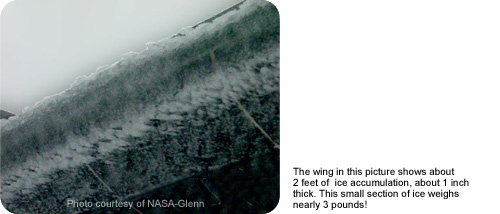
| page 2 |
CIRRUS Monthly Proficiency Program
3 part series on IFR operations
October – Part 3: Avoiding the Chills of an Icing Encounter
The October CIRRUS Month Proficiency Program Ground Segment reviews the topic of icing:
- Where icing is likely to occur
- How to obtain icing information
- What to do if you encounter icing
NOTE: CIRRUS AIRPLANES ARE NOT APPROVED FOR FLIGHT INTO KNOWN ICING CONDITIONS.
According to the Air Safety Foundation, 12% of all weather-related accidents have something to do with icing, and 64% of those occurred in fixed-gear, single-engine airplanes. One may want to assume that this happens to the new pilot with little varied-weather flying experience. Not so.
ASF statistics show that 48% of weather-related accidents involve pilots with more than 1000 hours of flying experience. Icing, therefore, is of special importance to single-engine, general aviation airplanes that are not certified for flight into known icing conditions.
NTSB Accident Report
Begin your Ground Segment by clicking on the following
link to review the NTSB accident report:

Analyze the accident. Think about how the pilot could have
prevented it.
- What affect did the pilot’s insufficient knowledge of the airplane’s operating limitations have on the outcome?
- Could the pilot’s disregard of the weather briefing be attributed to his/her lack of understanding of weather theory and phenomena?
- What could have caused the engines to fail, and how could a better understanding of airplane systems have alleviated this problem?
- What weather reports or forecasts could the pilot have used to determine the weather along his/her route?
- What reaction or response to the adverse weather conditions by the pilot could have resulted in a desirable outcome for this flight?
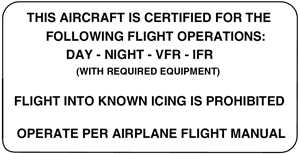
| Page 3 |
CIRRUS Monthly Proficiency Program
3 part series on IFR operations
October – Part 3: Avoiding the Chills of an Icing Encounter
Known
vs. Unknown Icing1
All airplanes receive certification for Kinds of Operations.
This information can be found in Section 2 of an airplane’s
Pilot’s Operating Handbook. Here the pilot can determine
if the airplane is certified for flight into known icing or if flight into known icing conditions is prohibited.
Even though some airplanes may have systems, such as the TKS Weeping Wing, these airplanes cannot fly into known icing conditions unless they are specifically certified to do so. Airplanes without a certification for known ice have not necessarily been tested under icing conditions for performance or handling characteristics. Pilots are advised not to dwell in or prolong flight through these conditions even in airplanes that may be certified for flight into known icing.
Remember: ice adds weight and weight reduces lift just when you may need it most! Even a thin layer of frost on the leading edge or upper surface of the wing can reduce lift by up to 30%.
Forecasted icing along a route also constitutes a condition of known icing. A pilot who flies a noncertified airplane into an area of forecasted known icing would be operating illegally—unless there is en route information to say that the forecasted conditions have changed to a nonicing situation.
|
|
Ice is relatively rare in snow conditions. | ||
1John S. Yodice’s article in the August 2005’s edition of AOPA Pilot Magazine highlights recent cases of known vs. unknown icing conditions. Only AOPA members have access to the article.
| Page 4 |
CIRRUS Monthly Proficiency Program
3 part series on IFR operations
October – Part 3: Avoiding the Chills of an Icing Encounter
Types of Ice
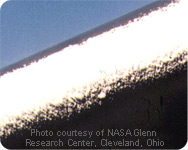 RIME
RIME
A white or milky and opaque granular deposit of ice
formed by the rapid freezing of supercooled drops/droplets after
they strike the airplane. The rapid freezing results in air being
trapped, giving the ice its opaque appearance, making it porous
and brittle. Rime weighs less than clear ice, but it may seriously
distort airfoil shape and thereby diminish lift.
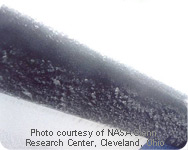 CLEAR
CLEAR
Clear ice, or glaze, results from supercooled drops/droplets
striking the surface but not freezing rapidly on contact. Flight
through supercooled rain at an air temperature of 25°F to
32°F (-4° to 0°C) is most conducive to clear icing.
Clear ice is denser, harder and sometimes more transparent than
rime ice. Clear ice does not seriously distort airfoil shape,
but it does add appreciably to the weight of the craft.
MIXED
A combination of rime and clear ice, mixed ice forms
in nonuniform clouds at moderate temperatures.
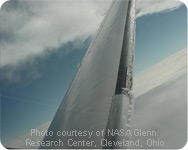
| Page 5 |
CIRRUS Monthly Proficiency Program
3 part series on IFR operations
October – Part 3: Avoiding the Chills of an Icing Encounter
![]() Planning Your Flight
Planning Your Flight
Avoiding ice begins well before the wheels have left the pavement. Thorough
preflight planning can minimize the likelihood of flying into icing conditions.
AIRMETS, SIGMETS, winds-aloft forecast, Pilot’s Report (PIREP) and
a pilot’s understanding of frontal activity can all give a clear notice
of where icing conditions exist.
|
|
Having oxygen onboard allows you to climb above the clouds to avoid ice. | ||
Ice can be extremely dangerous! Before attempting any flight where temperatures are hovering around freezing, the pilot should ensure a safe passage around or under the potential icing. If in doubt, delay your flight.
Evaluating PIREPs
PIREPs provide reports from pilots currently in the air
and can either confirm or dispel the forecasted conditions.
There is no set time at which a pilot’s report
becomes invalid, but pilots are expected to objectively
look at conditions and report them clearly and succinctly.
Regardless, PIREPs are subjective, and caution should
be used in evaluating any PIREP.
What may be light icing to one pilot may be moderate to another. What is light icing for a commercial plane may be severe icing to a small airplane.
Additionally, PIREP reports are airplane-, time- and space-specific. Depending on the type of airplane flown and when the pilot filed the report, as well as location (height) in relation to your own flight path, a particular PIREP may have little bearing on your situation.
Finally, actual icing areas can vary considerably from quite small and isolated to spread out over a large region, so distance from the PIREP location to your own flight path should be considered in your evaluations.

| Page 6 |
CIRRUS Monthly Proficiency Program
3 part series on IFR operations
October – Part 3: Avoiding the Chills of an Icing Encounter
Planning Ahead
On long flights, frontal activity may be conducive to icing
conditions. Figure 1 shows areas where icing formations
are common (bearing in mind that temperatures generally
must be in the icing range somewhere in the vertical
structure of the fronts).
The best course of action when planning flights that cross weather fronts is to cross the front as perpendicular as possible, rather than paralleling the front, to minimize your exposure to potential icing conditions. Crossing at a 90° angle will minimize time in any potential icing situation. In reality, if you plan for a course deviation to avoid icing, you will be extending the flight time only minimally.
 For
example, a flight from Minneapolis, Minnesota, direct to
Louisville, Kentucky, would be paralleling the front in
Figure 1 and you would likely be flying through icing conditions.
Choosing a route via Des Moines, Iowa, and St. Louis, Missouri,
to Louisville will avert this hazard and will save time
and the chills of having to make a larger diversion halfway
into the flight.
For
example, a flight from Minneapolis, Minnesota, direct to
Louisville, Kentucky, would be paralleling the front in
Figure 1 and you would likely be flying through icing conditions.
Choosing a route via Des Moines, Iowa, and St. Louis, Missouri,
to Louisville will avert this hazard and will save time
and the chills of having to make a larger diversion halfway
into the flight.
During the preflight planning process, it is important to have an exit strategy, a list of “outs” for leaving the area. These ‘’outs’’ are designed to help pilots escape inadvertent icing encounters.
| Page 7 |
CIRRUS Monthly Proficiency Program
3 part series on IFR operations
October – Part 3: Avoiding the Chills of an Icing Encounter
Planning Ahead (continued)
In any icing encounter a pilot has six outs: climb,
descend, continue, divert, return and declare
an emergency. Prior
to beginning a flight with potential icing, pilots should
try to evaluate which of these outs will be appropriated.
- Climb when it is
possible to reach warmer temperatures or to exit the
clouds or icing conditions. PIREPs from other airplanes
can sometimes be checked to obtain temperatures and flight
conditions at higher altitudes. In addition, you can
use the temperatures from the winds-aloft forecast.
Pilots should be aware that the most severe icing is often towards the tops of the clouds. As the water vapor rises and condenses, it releases energy, becoming effectively more buoyant. This buoyancy creates extra turbulence that causes any supercooled water droplets to reconstitute into icing conditions. - Descending should
clearly be chosen when warmer conditions exist below
you. Again, PIREPs from other airplanes can be helpful
in this respect. Pilots need to also consider minimum
en route altitudes (MEA) when planning on descending.
If the flight is already flying at the MEA, or if the warmer temperatures are below the MEA, it may not be possible for the flight to exit the icing conditions. Some other action would need to be taken, such as requesting that air traffic control permit a descent to the minimum obstacle clearance altitude. - Continue when the
flight will be leaving any icing conditions. This out
is a difficult one to predict and should be used only
when it is certain that warmer temperatures are ahead.
Utilizing the XM Satellite weather system, if equipped, can help the pilot determine if conditions ahead of the airplane are improving or if they require the pilot to divert. - Diverting is the
favored out when it is clear that the actual conditions
are worse than forecasted. Again, special attention should
be paid when crossing fronts. On long legs, use the en
route briefings from Flight Watch and Flight Service
Stations, as well as monitoring of local ASOS and AWOS
stations to determine the front’s position and
motion.
If the airplane is equipped with XM Satellite weather system, the pilot can utilize the information presented on the Multi-Function Display to help determine where there is an escape route. - Return when actual
conditions turn out to be worse than the forecast suggested
at your time of departure. Monitoring the outside air
temperature gauge on climb-out can advise you if the
temperatures are holding to the forecast, or if they
are worse than planned.
If the temperatures drop into the icing range and hold, do not hesitate to return to your departure airport. It may be the best decision you make on that trip! - Declare an
Emergency at any time
that the safety of the flight is in question. An emergency
situation will give you priority
handling from air traffic control as well as immediate
assistance in exiting the icing conditions. The pilot
will need
only to fill out additional paperwork if requested to
do so by ATC
after the event.
Pilots should not delay conveying the urgency of their request to ATC. Simply stating you are picking up ice will not necessarily mean that ATC is going to give you priority handling. Avoid waiting until it is too late to declare an emergency situation.
| Page 8 |
CIRRUS Monthly Proficiency Program
3 part series on IFR operations
October – Part 3: Avoiding the Chills of an Icing Encounter
Inadvertent
Icing Encounters
If ice begins accumulating on the airplane, immediately try
to determine the rate of accumulation. The Aeronautical Information
Manual lists the different levels of icing:
- Trace ice is icing that has become perceptible. The rate of accumulation is slightly greater than sublimation. Deicing/anti-icing equipment is not utilized unless this condition is encountered for an extended period of time (perhaps over one hour).
- Light. . Here the rate of accumulation may create a problem if flight is prolonged in this environment (over one hour). Occasional uses of the deicing/anti-icing equipment will most likely remove or prevent accumulation. It will not present a problem if the deicing/anti-icing equipment is used.
- Moderate. The rate of accumulation is such that even short encounters become potentially hazardous and use of the deicing/anti-icing equipment or flight diversion is necessary for continuation.
- Severe. The rate of accumulation is such that deicing/anti-icing equipment is simply inadequate. Immediate flight diversion is necessary.
- FREEZING RAIN OR FREEZING DRIZZLE ARE RISKY. EXIT THE AREA IMMEDIATELY!
When trying to exit the icing conditions by changing altitude, pilots may be told to stadby for crossing traffic or ATC congestion. You are encouraged to advise ATC that you are willing to take a heading change to expedite your altitude change. Choosing to take a heading change will limit your time in the icing environment and will as indicate to ATC the urgency of your situation.
|
|
When in ice and you’re in doubt whether to climb or descend, climb first. You can always descend later. |
||
If the icing encounter becomes severe, immediately disengage any autosystems and hand fly the airplane. Hand flying allows pilots to feel any aerodynamic anomalies that could occur as ice builds on the airplane and to immediately make suitable compensations. Aside from the aerodynamic effects, ice can accumulate heavily and diminish lift, just when you may need it most!
In training, pilots learn to looked for emergency landing fields on a cross-country trip. The same strategy should be followed with respect to icing.
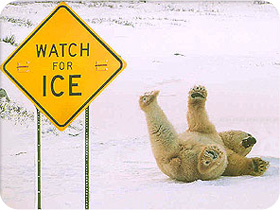
| Page 9 |
CIRRUS Monthly Proficiency Program
3 part series on IFR operations
October – Part 3: Avoiding the Chills of an Icing Encounter
CIRRUS Systems Available to Help Exit Icing
TKS
Some Cirrus SR22 (not available for Cirrus SR20) airplanes
may be equipped with the optional TKS system, which uses
glycol to prevent the formation of
ice on the wings, horizontal stabilizer and propeller. If a pilot encounters
inadvertent icing, this system can be turned on to help alleviate the ice
build-up and allow the pilot to make a safe diversion.
|
WARNING: |
||
The TKS system consists of six porous panels on the wings and horizontal leading edges, propeller slinger ring, four proportioning units, metering pumps, filter strainer, fluid tank, activation switch, filler cap, system plumbing, and attaching hardware.

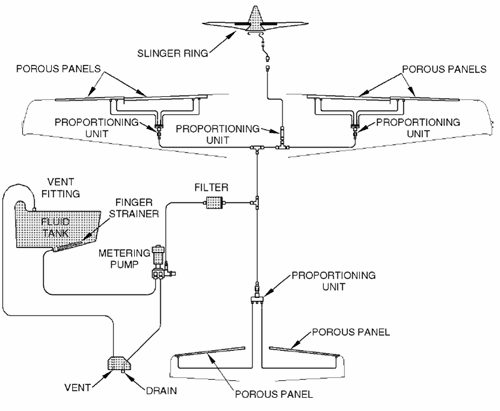
| Page 10 |
CIRRUS Monthly Proficiency Program
3 part series on IFR operations
October – Part 3: Avoiding the Chills of an Icing Encounter
TKS (continued)
The TKS fluid tank has a total capacity of 2.96 gallons (11.20
liters), and when operated in the normal mode will provide
approximately one hour of operating time. When in maximum
mode, the system will provide approximately 30 minutes
of operating time.
There is no fluid tank quantity indicator, which means that the pilot must perform a careful preflight to ensure that the fluid tank is full. During flight, the pilot must use a timer to monitor fluid usage.
|
Note: The Ice Protection System is certified only as “No Hazard” to normal operations; therefore, no determination has been made as to the capability of this system to remove or prevent ice accumulation. |
||
|
Note: Utilizing the TKS system will result in a decrease of approximately 3 knots and will reduce range by a maximum of 2%. |
||
| Page 11 |
CIRRUS Monthly Proficiency Program
3 part series on IFR operations
October – Part 3: Avoiding the Chills of an Icing Encounter
TKS (continued)
To ensure that the TKS system is fully operational, a pilot
should perform monthly checks of the system to verify that
glycol flows out from the porous panels and slinger ringer.
Additionally, if a pilot plans a flight and there is a
potential that icing conditions will be encountered, the
pilot should prime the system prior to departure. Priming
the system will ensure that when the system is activated,
there is a minimal delay for the glycol to reach the protected
surfaces.
How to Prime the TKS System
Follow these steps to prime the TKS system:
- Turn on the system on the ground while conducting the preflight.
- Confirm that glycol is being dispensed from all of the porous panels and the propeller slinger ring. Note: Because the propeller is not spinning, the glycol will pool in the slinger ring and run down the lower cowling.
- Re-fill the fluid tank with glycol.
| Page 12 |
CIRRUS Monthly Proficiency Program
3 part series on IFR operations
October – Part 3: Avoiding the Chills of an Icing Encounter
Pitot Heat
Both the Cirrus SR22 and the Cirrus SR20 come equipped with
a heated pitot tube, which is activated by a switch located
on the bolster panel. The pitot heat switch should be activated
when flying in any type of visible moisture and when the
outside air temperature is conducive to icing.
The CIRRUS has a Pitot heat light, which will illuminate when the Pitot heat switch is activated and no current is being received at the Pitot tube. A current sensor on the Pitot heater power supply wire provides current sensing.
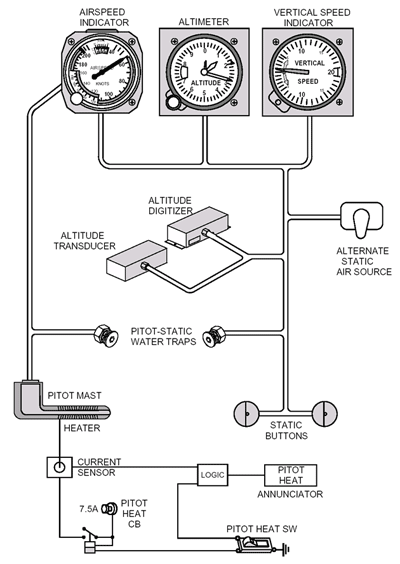
| Page 13 |
CIRRUS Monthly Proficiency Program
3 part series on IFR operations
October – Part 3: Avoiding the Chills of an Icing Encounter
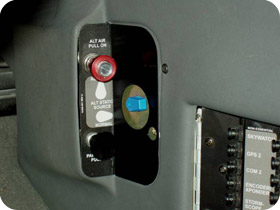 Alternate Static Source
Alternate Static Source
In the unlikely event that the static ports on the CIRRUS
become plugged with ice, the pilot can activate an alternate
static
source via a knob located next
to the pilot’s right leg. When activated, static pressure is taken from
inside the airplane cabin. Static pressure will vary depending upon whether
the heater and fresh air vents are open.
Static pressure from inside the airplane
will be lower than static pressure outside the airplane. As a result, you
might notice a rise in the altimeter
and airspeed indicator, and a momentary jump in the vertical speed indicator.
Always refer to section 5 in the Pilot Operating Handbook (POH) when using
the alternate static source.
| Page 14 |
CIRRUS Monthly Proficiency Program
3 part series on IFR operations
October – Part 3: Avoiding the Chills of an Icing Encounter
Defrost System (Environmental System)
CIRRUS airplanes are equipped with an environmental system
that allows the pilot to turn on cabin heat. Cabin heat
is controlled by the cabin heat control selector, which
is located on the lower right side of the instrument panel.
The cabin heat control selector, which is between the heater muff and the mixing plenum, is mechanically linked to a door in the heater box. The cabin heat control selector must be turned clockwise to allow heated air to enter the cabin. As with most single-engine airplane heating systems, the pilot must be aware of the potential danger of carbon monoxide poisoning.
|
|
If possible, avoid flying at dusk. When the sun goes down, temperatures typically get cooler and you can quickly find yourself in an icing band. |
||
| Page 15 |
CIRRUS Monthly Proficiency Program
3 part series on IFR operations
October – Part 3: Avoiding the Chills of an Icing Encounter
Defrost System (Environmental System) (continued)
Engaging the cabin heat control selector only allows the heated air to enter
the cabin. To direct the heat either to the windshield or to passengers,
the pilot must use the cabin heat/defroster selector. The heat/defroster
selector is located on the bottom right side of the instrument panel.
Rotating the heat/defroster selector control knob counterclockwise shuts off airflow to the passengers and allows the airflow to windshield. Rotating the heat/defroster selector knob clockwise reverses the process.
The heat/defroster selector knob can be set at an intermediate position to provide a mix of warm air to be directed at the passengers and windshield.
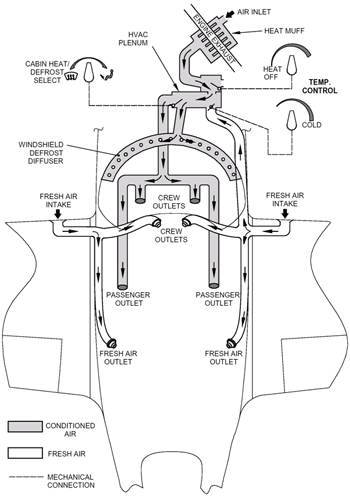

| Page 16 |
CIRRUS Monthly Proficiency Program
3 part series on IFR operations
October – Part 3: Avoiding the Chills of an Icing Encounter
Alternate
Air If a pilot suspects a clogged air intake manifold, activate the Alternate Air Source by pulling the red Alternate Air Source knob, which is located near the pilot’s right leg. Pulling the knob opens the alternate air induction door on the engine induction manifold, bypassing the air filter, allowing warm unfiltered air to enter the engine. According to the POH in section 3, if a pilot encounters icing, the Alternate Air Source should be activated. |
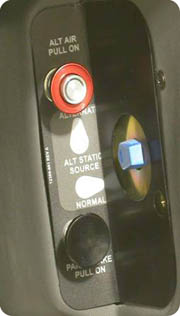 |
| Page 17 |
CIRRUS Monthly Proficiency Program
3 part series on IFR operations
October – Part 3: Avoiding the Chills of an Icing Encounter
XM Satellite Weather
On CIRRUS airplanes so equipped, XM Satellite weather information
is available on the Multi-Function Display. Use XM Satellite
weather to locate precipitation along the route and access
METARS to determine cloud bases and temperatures for planning
a diversion.
What to Do If You Encounter Icing:
- Activate TKS system (if installed).
- Normal or maximum depending upon the severity of the ice condition
- Activate pitot heat.
- Activate Alternate Air Source.
- Activate the environmental system.
- Activate Alternate Static Source, if required.
- Take appropriate action to get out of the icing situation.
- Climb or Descend or Divert.
- Declare an emergency if required.
- Utilize all of your resources to help plan an exit strategy.
- XM Satellite Weather, if installed
- Flight Service Station
- Flight Watch
- ASOS, AWOS, and ATIS
| Page 18 |
CIRRUS Monthly Proficiency Program
3 part series on IFR operations
October – Part 3: Avoiding the Chills of an Icing Encounter
Conclusion
Ice and icing conditions are not friendly encounters for
pilots and should be avoided if possible, minimized at
least and taken seriously at all times. Proper planning,
from pre-flight to continuous in-flight evaluation, is
smart and safe. Relying on deicing/anti-icing equipment
in airplanes certified for flight into known ice may be
sufficient to a point—but it is not absolutely
reliable.
Pilots of small general aviation airplanes, especially those not certified for flight into known icing conditions, are advised to make go/no-go decisions as if their airplane does not have any type of de-icing/anti-icing equipment.
Being aware of the potential of icing on a trip and having ‘‘out’’ strategies is a worthy investment of time. Delaying a trip or diverting from a straight-line route may be the best safety decision.
Ice in your drink at the end of the flight is better than ice on your wings!
References:
Yodice, John S. “The Law on Known Icing.” AOPA
Pilot Magazine (August 2005).
Icing for General Aviation Pilot’s. NASA and
AOPA, 2002. VHS.
![]()
| Page 19 |
CIRRUS Monthly Proficiency Program
3 part series on IFR operations
October – Part 3: Avoiding the Chills of an Icing Encounter
![]()
Objective:
Continuing the balance of a need for
speed with a concern for safety, the flight portion for the
October CIRRUS Monthly
Pilot Proficiency program will increase your knowledge
of and ability to use the systems onboard your airplane
should you encounter icing conditions., You will also learn
about how to plan an exit strategy.
Complete the lesson in good visual flight rules weather conditions and at no time enter any conditions conducive to icing. All pilots will benefit from having a CSIP instructor onboard to facilitate an instructor-led scenario.
|
To learn more about CSIP instructors available in your area, go to: www.CIRRUSdesign.com/csip |
||
Plan a three-leg cross-country with airports a minimum of 30 minutes apart. This will ensure that the CSIP instructor has time to set up an icing scenario for you to work your way through.
Items to Simulate
- Inadvertent flight into icing
- Diverting
- Practice communicating with Flight Service Station and/or Flight Watch to obtain en route weather
- Use XM Satellite weather, if installed, to pull up METARS to determine cloud bases, temperatures and where VMC weather exits
![]() For
a Printable PDF version of this information, CLICK HERE.
For
a Printable PDF version of this information, CLICK HERE.
![]()
| Page 20 |
CIRRUS Monthly Proficiency Program
3 part series on IFR operations
September– Part 2: Primary Flight Display (PFD)
![]()
You will successfully complete the October CIRRUS Monthly Pilot Proficiency Program when you gain a thorough understanding of the conditions under which you will encounter icing conditions, and what exit strategies to consider if you do encounter icing conditions
You will be able to:
- Determine the appropriate action: whether to climb, descend, divert, continue, or return
- Use all available resources to help make the appropriate decision
Thanks for visiting CIRRUS Pilot’s World and taking the October Monthly Proficiency Program. We hope you enjoyed the experience and that it has helped to increase your awareness, skill and proficiency in safely flying your CIRRUS SRV, SR20 or SR22. Please take a moment to give us your feedback about this month’s course. Your suggestions will help us provide you with courses to improve your all-around flying safety and enjoyment Write to us at: pilotsworld@cirrusdesign.com. See you next month!
|
| Page 21 |

